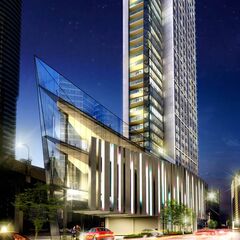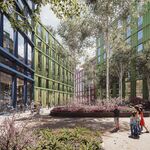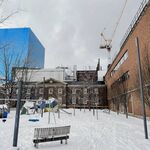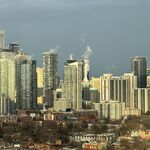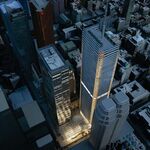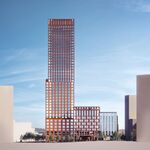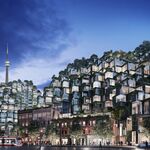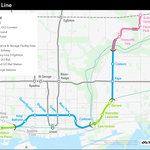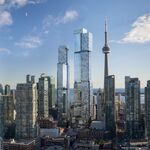Jointly developed by Tridel and Build Toronto, Ten York will occupy a challenging 0.6 hectare site on the west side of York Street just south of the Gardiner Expressway. Part of the regeneration of the underutilized lands between the rail corridor and Toronto Harbour, the creation of an attractive pedestrian connection between these areas is critically important to Toronto's burgeoning south core as is the achievement of an architecture befitting its prominent location. The dramatic changes that transformed the 65-storey residential project after its release to the project as it appears today are uncharacteristic of the development process and are a direct response to the demands of its location. The images found below document this transformation and provide clear evidence of the constructive relationship between Waterfront Toronto, Wallman Architects and Tridel that gave rise to this thoughtfully conceived project.
 A rendering of the revised proposal within the context of the central waterfront, image courtesy of Wallman Architects
A rendering of the revised proposal within the context of the central waterfront, image courtesy of Wallman Architects
There is a strange dichotomy to the discussion of the arts in Toronto; a division that typically leaves architecture as something of a secondary concern. Although exceptions are found in the construction of some of our cultural institutions and among the towering expressions of corporate ego in the financial district, high-rise residential design has rarely kept pace. The resulting mediocre designs clad in equally forgettable materials have had a little positive impact on the creation of an attractive city and done less then they could to set a higher standard for design.
A challenge to this prevailing attitude, however, has surfaced during the city's latest and remarkably protracted construction cycle. A comparison of the dense cluster of recent projects along King Street West with those of Bay Street's compilation of 1980s era buildings provides a stark and exciting example of progress. A combination of an increasingly sophisticated development industry, the use of architectural firms with a demonstrable talent for residential design, and robust municipal regulations have all acted to improve what we build. The evolution of Ten York Street Condos provides a useful insight into this process; offering evidence as to its effectiveness and necessity.
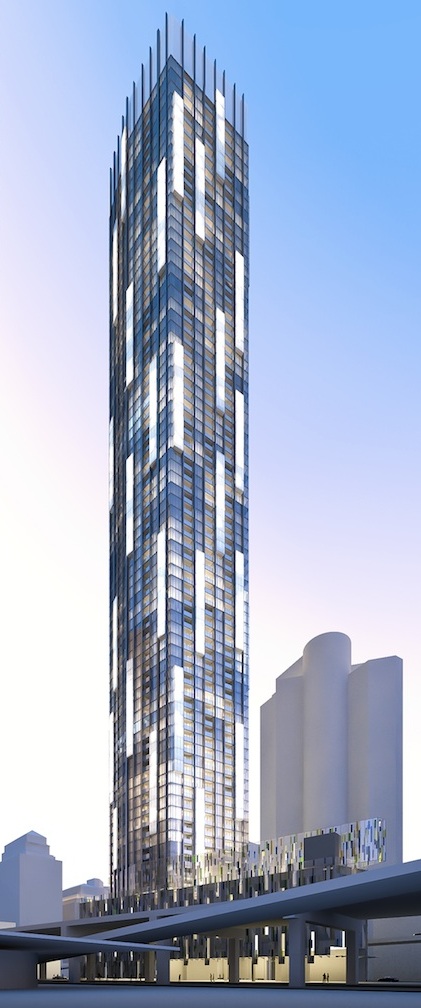 Initial rendering of Ten York released in 2011, image courtesy of Wallman Architects
Initial rendering of Ten York released in 2011, image courtesy of Wallman Architects
The challenge of its location in a poorly defined transitionary zone between the financial district and the waterfront is compounded by the triangular shape of the site. As explained by lead architect Rudy Wallman, not only is the land hemmed in by a highway but "from a residential standpoint, [the site] is inefficient." Rectangular sites have a clear benefit in that their floorplates lend themselves to the creation of large amounts of usable square footage whereas triangular sites lose workable space at their corners. There are also logistical difficulties with triangular plans as they limit easy vehicle access while also reducing the ratio of cars per unit. The initial rendering of the project (above) as seen in November 2011 reflects this preference for a rectangular footprint.
The project's first incarnation attempted to correct for the inefficiencies of the site by placing a conventionally shaped tower atop a roughly triangular podium. Visual interest was sought through a "Northern Lights" motif on the tower's facade while a strongly patterned podium disguised the above-ground parking included therein.
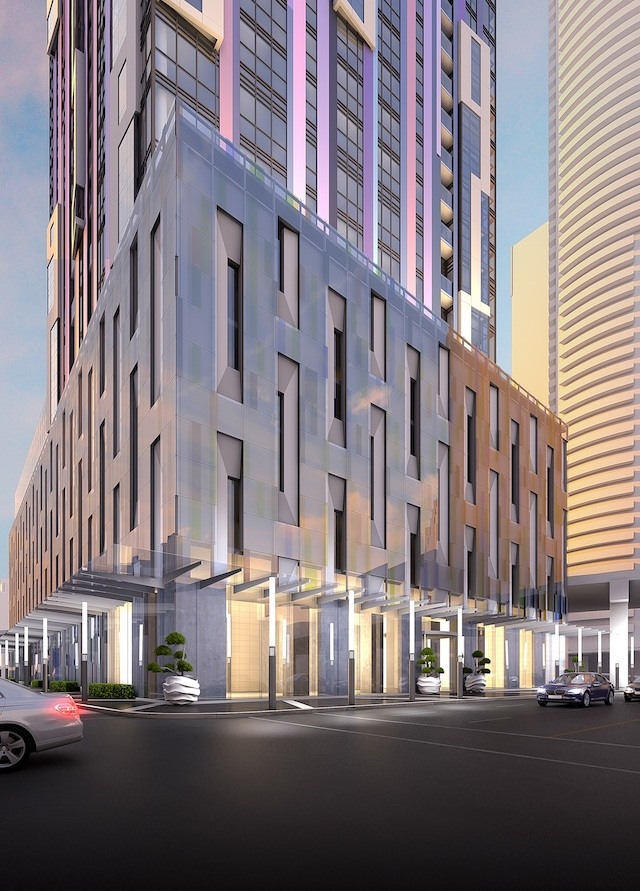 A rendering of the podium as first proposed, image courtesy of Wallman Architects
A rendering of the podium as first proposed, image courtesy of Wallman Architects
The subsequent evolution of the tower was subject to review by the Waterfront Design Review Panel. Established as an independent advisory body in 2005, the objective of the panel is to aid in the revitalization of the city's waterfront and was the first of its kind in Toronto. All projects to the south of Lake Shore Boulevard are subject to its oversight in addition to a large swath of land extending both to the east and west of the central waterfront. Not to be confused with the City of Toronto's Design Review Panel (DRP), this panel is a creation of the tripartite body Waterfront Toronto. As such, projects subject to its purview are exempt from the City's DRP and vice versa.
The importance of this process to Toronto's architectural maturation cannot be understated. As described by Wallman, they are "absolutely essential given the highly varied quality of what developers build… [and serve] to challenge the status quo." Often developers whose experience is wholly suburban struggle to adapt their design approach to downtown, the resulting importation of a suburban model results in projects that often lack the design sophistication suited to their more prominent downtown sites. The value of design review panels lays in their ability to help developers unfamiliar with the market adapt their approach to design while also building civic expectation for the quality of architecture in the city.
The series of alterations made to the project are partly reflective of this phenomenon. Although both the developer and the architect have considerable experience with high-density residential projects, the three-part review was useful in refining the design. The result of the initial evaluation saw the removal of the projecting glass fins on the roof, a coordination of the building's setbacks to match the existing buildings on York Street, a re-examination of the above-ground parking, a more unified aesthetic between tower and podium, as well as a push to reconfigure the floor-plate to match the triangular configuration of the site.
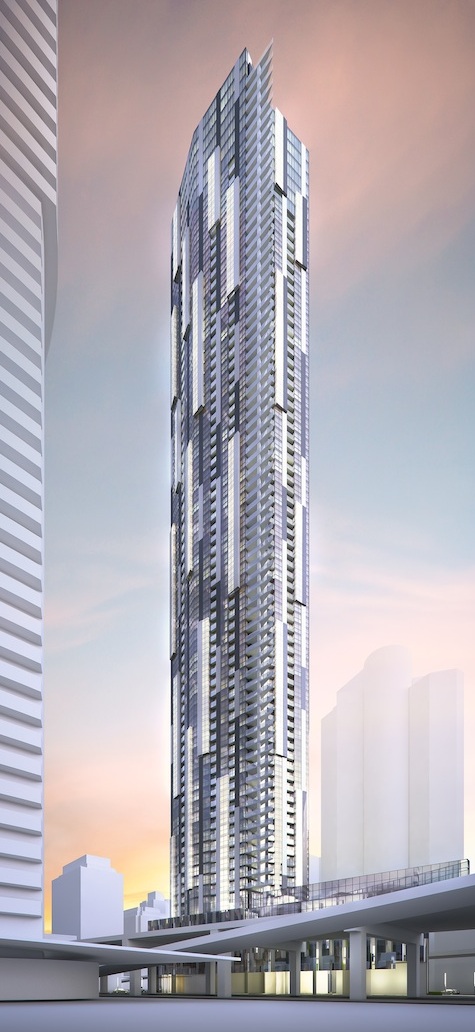 Revision to the tower, image courtesy of Wallman Architects
Revision to the tower, image courtesy of Wallman Architects
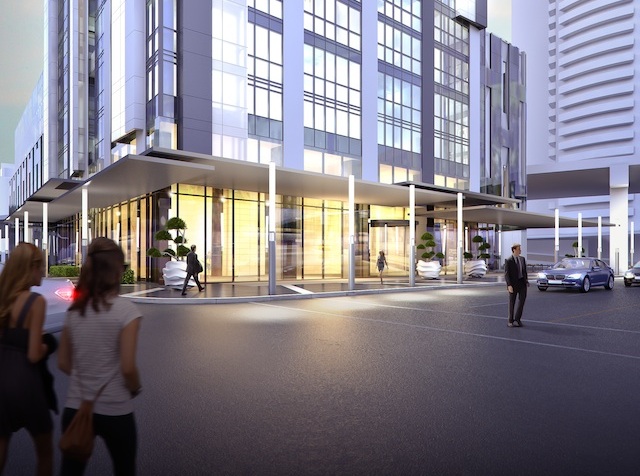 Alterations to the initial design showing a more minimal approach to the podium, image courtesy of Wallman Architects
Alterations to the initial design showing a more minimal approach to the podium, image courtesy of Wallman Architects
Further changes following the second review saw the replacement of the "Northern Lights" concept of the tower facade with a more minimal concept of a pattern of boxes running up the north and south elevations of the tower. A more substantial rooftop element was also added in order to address the panel's preference for a stronger expression for the top of the tower.
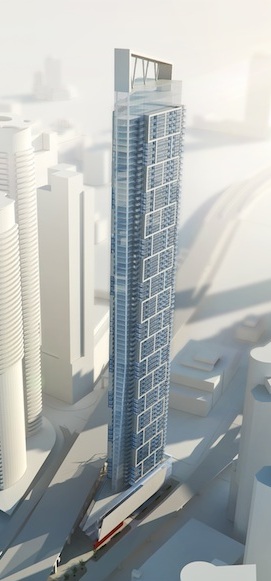 A rendering of the tower without the "northern lights" motif and with a pronounced rooftop feature, image courtesy of Wallman Architects
A rendering of the tower without the "northern lights" motif and with a pronounced rooftop feature, image courtesy of Wallman Architects
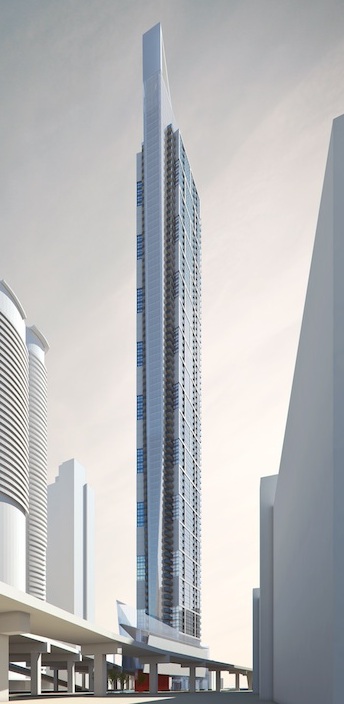 Street level perspective of the previous image, courtesy of Wallman Architects
Street level perspective of the previous image, courtesy of Wallman Architects
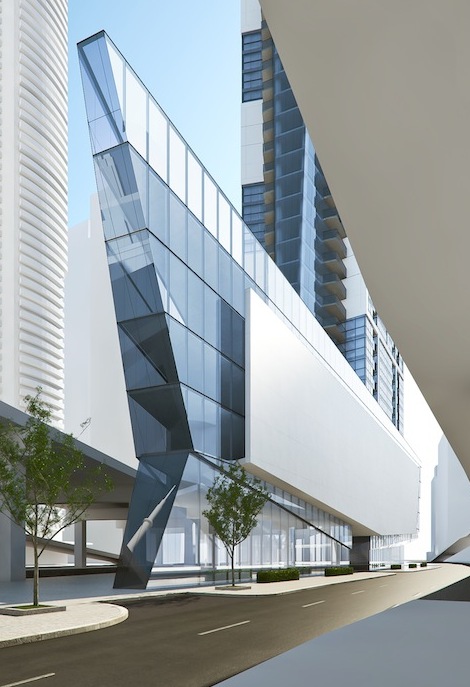 A further developed podium design, image courtesy of Wallman Architects
A further developed podium design, image courtesy of Wallman Architects
Additional refinements saw the floorplate of the building expanded and shaped to better correspond to the shape of the site. This was in response to the DRP's preference for a design that reflected the 'uniqueness' of the site and to 'celebrate' the inherent architectural possibilities. The unconventional triangular shape of the building, now with an enlarged floorplate to compensate, created a unit size and mix that remained practical and marketable. Unit design on the tapered western facade proved to be especially interesting as it afforded large layouts in excess of 1200 square feet while offering uncharacteristically expansive views at the prow of the building.
Requests for greater transparency at the base resulted in a new podium configuration that Wallman describes as "drama through sculpture" and created a sense of the tower "crashing through the glass enclosure." Reminiscent in shape to many well-known examples of the 'Flatiron' type and in transparency to New York's Fifth Avenue Apple Store entrance, the podium does more than most to ensure the project has an interesting street level presence.
Streetscape improvements designed by Janet Rosenberg & Studio landscape architects to be implemented in harmony with the York Street Promenade Plan are critical in linking the developing Southcore neighbourhood with the central waterfront. The installation of raised, granite-clad planting beds similar to those found outside of Maple Leaf Square with an expanded sidewalk width of 4 meters will improve the pedestrian experience in what is now a wholly unwelcoming segment of the city.
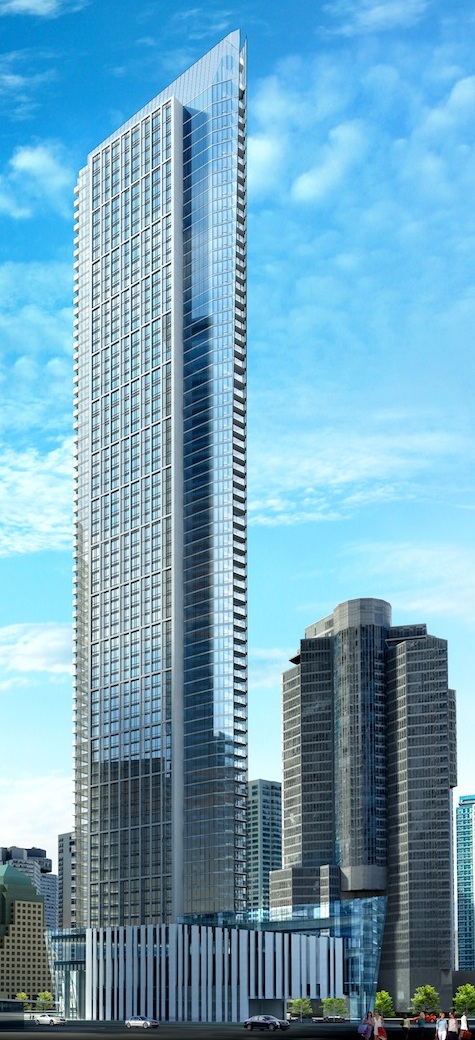 Rendering of the project in its final form with revised mechanical penthouse, image courtesy of Wallman Architects
Rendering of the project in its final form with revised mechanical penthouse, image courtesy of Wallman Architects
Revisions to the tower above include the use of commercial grade curtain wall on the north and south facades as well as the limited use of balconies at the west, southeast and northeast corners in order to preserve a clean look to the exterior. The uncharacteristic application of curtain wall to a residential building will set it apart from its peers and achieve the iconic image desired by the architect and the members of the panel.
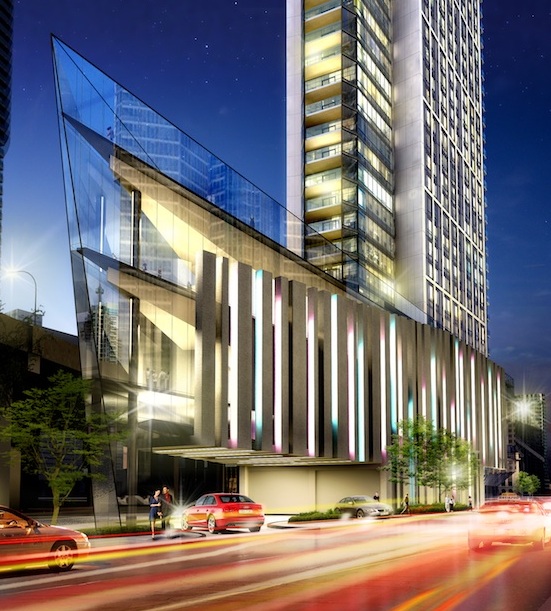 Evening rendering of the podium, image courtesy of Wallman Architects
Evening rendering of the podium, image courtesy of Wallman Architects
The necessary mechanical equipment on the top of the tower will be incorporated into a projection of the curtain wall above the uppermost floors. This vitreous extension will be shaped so as to provide continuity with the dramatic podium, helping to carry the kinetic energy of the design to the crown of the building.
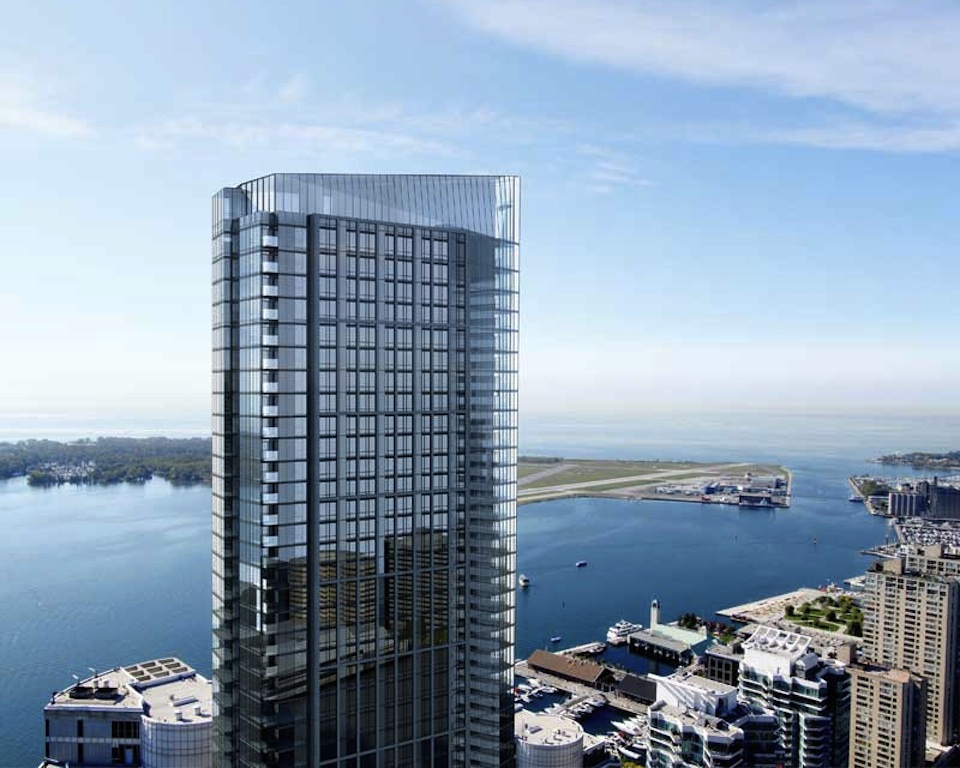 Skyline profile of Ten York, image courtesy of Wallman Architects
Skyline profile of Ten York, image courtesy of Wallman Architects
The final product speaks to the effectiveness of design review and demonstrates its important role in guiding the growth of the city. Critical to this process are developers who view thier products as instrumental to city building and architects that are able to successfully articulate this strategy in physical form. On all counts, this project is a welcome success.
 Ten York within the context of Toronto's core, image courtesy of Wallman Architects
Ten York within the context of Toronto's core, image courtesy of Wallman Architects
Further information can be found in the City of Toronto's planning report. To participate in our Forum discussion, follow the link here.
Urban Toronto would like to thank Rudy Wallman for his time and input.
| Related Companies: | II BY IV DESIGN, Janet Rosenberg & Studio, Rebar Enterprises Inc, Tridel, Unilux HVAC Industries Inc. |

 6.2K
6.2K 



